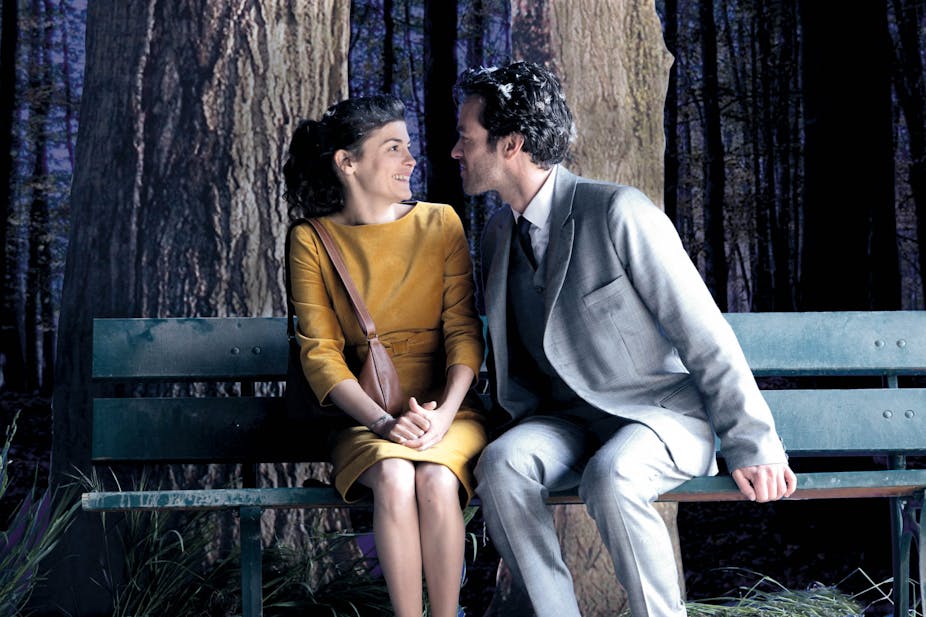Mood Indigo has received a number of enthusiastic reviews. I’m not sure why. The film takes quirky to an all new extreme. And as the French literary and comic substance to it have been pretty much completely excised for the international version, all that’s left is empty sparkle. That says a lot about what French filmmakers think Anglophone audiences want.
Versailles-born director Michel Gondry returned to his French roots for his most recent project after three acclaimed indie films (Be Kind Rewind, The Science of Sleep, Eternal Sunshine of the Spotless Mind) and one blockbuster turkey (The Green Hornet).
Mood Indigo was released in France in April 2013 and is now finally reaching cinemas in the UK and USA (after a lengthy “internationalising” process?). The film is an adaptation of Boris Vian’s 1946 surrealist novel, L’Écume des Jours, which translates as Froth on the Daydream. Boasting a stellar French cast led by Audrey Tautou, Romain Duris, Omar Sy and Gad Elmaleh, Mood Indigo is a tale of love and loss in a fantasy Paris re-imagined as a marvellous, magical lovers’ playground.
As befits the original title, the romantic leads are a frothily insubstantial pair. They are cartoon figures whose external world is a heightened version of their inner lives. Duris is Colin, the charismatic playboy with the endless fortune. He lives in a retro-fitted subway carriage suspended high about the Paris skyline, a bachelor-pad that boasts a “pianocktail” (a piano that produces cocktails as the notes are played), and a wizard-like right-hand man (Nicolas, played by Sy), who serves as alternately as chef, valet, and virtuoso dance master.
In this fabulous place, stop-motion eels slither down taps before finding their way onto Colin’s dinner plate, cakes spin and come to life, and the doorbell splinters into tiny scattering mechanical insects when it is rung. Deciding that the only thing missing from his life is love, Colin attends a dog’s birthday party, where he meets Audrey Tautou, the wide-eyed gamine. Her name is Chloé, but it may as well be Amélie.
As they dance to Duke Ellington’s Chloe (of course), their legs become rubberised and elongated. They go ice-skating in a rink overseen by a giant bird; they soar over Paris in a swan-shaped cloud; and they marry in a church transformed into a go-kart racing track, attended by friends and an effigy of the philosopher-guru Jean-Sol Partre. Visually inventive, very intermittently witty, and utterly frivolous, the film’s world is at once alarmingly simplistic and deeply complex. It is a world that corresponds only to the sheer intoxication this couple feel at being young, being alive, and being in love.

The film’s dark turn, when it comes, is both narrative and literal. At the height of this euphoria, Chloe develops a condition called “waterlily on the lung”. This necessitates the radical treatment of a constant supply of fresh flowers left to wilt on her chest. It also means that Colin has to seek manual employment in the “real world” to supplement the ever-declining fortune he has frittered away on passing pleasures.
Thematically and in terms of production design, it is probably here that the film comes into its own, supplementing the whimsical and saccharine with the strange and perplexing. The popular packaging of the first half is exposed in all its irritating shallowness, as the decay and disorder that are only ever just below the surface of life and happiness come fully to the fore. Gradually all colour is leeched from the screen, and the glossy surfaces of the subway carriage are shrouded in dirt and cobwebs. Spaces shrink as rooms darken and change shape; characters age inexplicably, mechanical marvels creak and grind to a halt. It is every bit as suffocating as the first half, but perhaps more impressive in its subtlety and melancholic tone.

Literary adaptation has long been a staple of French film production, popular with home audiences, but also easy to export to art house cinemas on the international circuit. In principle, Mood Indigo has everything going for it: a cult text, a filmmaker with a talent for creating worlds within worlds, and a cast that includes some of some of France’s hottest talent.
But the film really struggles to rise above being much more than an absurdist curiosity. Vian’s celebrated wordplay falls flat in translation. Petits fours, which means “little ovens” in French, are served from literal little ovens – this is one gag that makes the cut, but the majority are completely inaccessible. The endless contraptions that buzz and jump end up irritating more than they dazzle. Important contextual references to Sartre, de Beauvoir and Duke Ellington (including the film’s title) are diluted to a point where they baffle rather than entertain. And self-reflexive attempts to acknowledge the instability of narrative texts (pools of typists on assembly lines each bashing out a few words before the typewriter moves on) are too fragmented and fleeting to make any kind impact.
My guess is that this incoherence is principally a function of the film having been cut by 30 minutes for international distribution. Maybe it was felt that gimmicky extravagance would compensate for literary idiosyncrasy with Anglophone audiences. But even at 94 minutes, this felt like an overlong viewing experience. It’s a flawed rather than bad film, but the flaws are too overwhelming to ignore.

